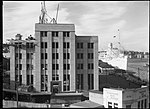The Museum of Contemporary Art Australia (MCA), located on George Street in Sydney's The Rocks neighbourhood, is solely dedicated to exhibiting, interpreting, and collecting contemporary art, from across Australia and around the world. It is the only contemporary art museum in Australia with a permanent collection. The museum is housed in the Stripped Classical/Art Deco-styled former Maritime Services Board Building on the western side of Circular Quay. A modern wing was added in 2012.
While the museum as an institution was established in 1991, its roots go back a half-century earlier. Expatriate Australian artist JW Power provided for a museum of contemporary art to be established in Sydney in his 1943 will, bequeathing both money and works from his collection to the University of Sydney, his alma mater. The works, along with others acquired with the money, were exhibited mainly as a traveling collection in the decades afterward, stored in two different university buildings, until the MSB building became available.
At its founding, it was called the Museum of Contemporary Art, Sydney. It rapidly outgrew its space and ran into financial difficulties that were alleviated in the early 21st century under new director Elizabeth Ann Macgregor, who eliminated regular admission fees and diversified the museum's funding sources. After two proposed expansions failed, a design by local architect Sam Marshall met with sufficient approval to raise money for its construction. From 2010 the building underwent a A$58 million expansion and re-development, reopening in 2012 as the Museum of Contemporary Art Australia.Power's original intent was for the museum to exhibit contemporary art from all over the world, with work by Australian artists shown only if it was relevant to the other works, but its focus has since changed primarily to Australian contemporary art. The museum's collection contains over 4,000 works by Australian artists acquired since 1989. They span all art forms with strong holdings in painting, photography, sculpture, works on paper, and moving images, as well as significant representation of works by Aboriginal and Torres Strait Islander artists. The museum runs programs to engage the interest of youth and disabled communities in appreciating and making art.












